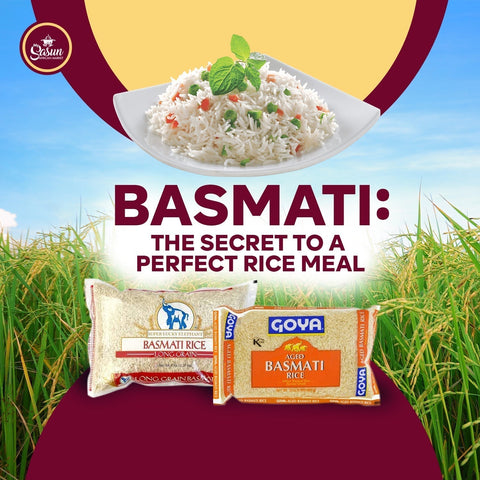Basmati rice has been around for centuries. It comes from the foothills of the Himalayas, where farmers have been growing it for over a thousand years. The name "Basmati" actually means "fragrant" in Sanskrit, and that makes sense because the rich aroma Basmati sends across the whole house when it is being cooked cannot be mistaken.
This rice isn’t new, but it has definitely gone global. It was once a luxury, reserved for kings and special occasions. Now, you’ll find it in kitchens all over the world, from Indian biryanis to West African jollof. Even if you just steam it and eat it with stew, it feels like you put in an extra effort- so extraordinary!
Also Read: Various Nigerian Rice Recipes for Different Occasions

Where Is Basmati Most Popular?
The biggest producers of basmati rice are India and Pakistan. They grow it in the perfect climate that us best for it- hot days, cool nights, and rich soil that gives the rice its unique texture and smell. In these countries, basmati is a part of daily life. It’s served with spicy curries, grilled meats, and rich, slow-cooked dishes.
But it doesn’t stop there. Basmati has made its way into African, Middle Eastern, and even Western kitchens. In West Africa, people love it for jollof rice because the grains stay separate and soak up flavors beautifully. In the Middle East, it’s the base for dishes like kabsa and mandi. And in the West, it's often the go-to rice for everything from pilafs to rice salads.
Also Read: Angwamo: How to Make Ghana's Oiled Rice

What Makes Basmati Different?
All rice is not the same. Basmati has some special qualities that set it apart:
It’s extra long – Basmati grains are longer than regular rice, and they get even longer when cooked. No short, stubby grains here.
It’s light and fluffy – The grains don’t stick together, which is why it works so well in so many dishes.
It’s aromatic – Basmati has a natural nutty, floral scent that makes it special. You don’t even need to add spices—just boiling it fills the kitchen with a warm, comforting smell.
It soaks up flavors – If you're making anything saucy, basmati is the best choice. It absorbs the seasonings without getting mushy.
Also Read: Top African Rice Dishes You Must Try

How Do You Cook Basmati Rice Right?
If you want restaurant-style basmati rice at home, here’s what you need:
Ingredients:
- 2 cups basmati rice
- 4 cups water
- 1 tablespoon butter or margarine
- Salt to taste
Instructions:
1. Rinse the Rice: Place the basmati rice in a bowl and rinse under cold running water until the water runs clear. This helps remove excess starch and prevents the rice from becoming sticky.
2. Boil Water: In a medium-sized pot, bring 4 cups of water to a rolling boil over high heat.
3. Add Rice and Salt: Once the water is boiling, add the rinsed rice and a pinch of salt. Stir briefly to prevent the rice from clumping.
4. Cook the Rice: Allow the rice to boil uncovered for about 8–10 minutes, or until it's al dente (cooked but still firm).
5. Drain the Rice: Pour the rice into a sieve or colander to drain the hot water.
6. Steam the Rice: Return the drained rice to the pot, reduce the heat to low, and add the butter or margarine. Cover the pot with a tight-fitting lid and let the rice steam for an additional 5–10 minutes. This step ensures the rice becomes fluffy and absorbs the buttery flavor.
7. Fluff and Serve: Once done, fluff the rice gently with a fork to separate the grains. Serve warm alongside your favorite Nigerian stews or sauces.
Note: While some Nigerian recipes may not traditionally include butter or margarine, adding it can enhance the flavor and help keep the grains separate.
Also Read: How to Cook Perfect White Rice Without It Sticking

Find Your Perfect Basmati Rice
At My Sasun African Market, we have some of the best basmati brands:
- Tropical Sun Golden Sella (5kg) – This one is parboiled, which means it holds its shape well. Great for jollof, fried rice, or anything saucy.
- My Sasun Basmati Rice (10lb) – Our very own! Soft, fluffy, and perfect for everyday cooking. If you eat rice often, this is a solid choice.
- Super Lucky Elephant (5lb) – If you like your rice soft and fragrant, go for this one. Perfect for plain rice with stew or grilled meat.
- Dunar Elonga & Festiva – Extra-long grains that look beautiful on the plate. If you want restaurant-style rice at home, these are great.
- Dunar Basmati Rice (10lb) – Same high quality as the others, just in a bigger bag. Good for families who cook a lot of rice.
- Goya Aged Basmati (5lb) – Aged rice has a stronger aroma and firmer texture. If you’re making biryani or pilaf, this is the one you want.
Also Read: How to Cook Perfect Jollof Rice Without Burning It

Rounding Off
That’s it. Perfect, fluffy basmati rice every time. Time to stock up, friend! If you love rice, a good bag of basmati is a must-have. It works for so many dishes and instantly makes a meal feel complete. Stop by My Sasun African Market and grab your favorite brand. Your kitchen will smell amazing, and your food will taste even better.
What’s your favorite way to eat basmati? And what is your favorite brand to eat? Let’s talk about it in the comments!







Comments (30)
i got 100 % cure and all the warts and pains got disappeared , i shared this post because it’s part of my life experience , encase anyone need speedy help about this cure Dr Agbon i was diagnosis with Herpes Simplex Virus ( HSV1&2 ) 7years ago and i meant a doctor he told me there is no cure. and i have taking some medication the warts multiplied when trying to removed them and it got me embarrass and pains , luckily few weeks ago i was recommend to Dr Agbon for natural treatment after Three weeks medication i was totally cured … him also cure the following list 1 ) Herpes 2 ) Diabetes 3 ) Hepatitis 4 ) Asthma 5 ) HPV 6 ) cold sores 7 ) arthritis 8 ) cancer 9 ) thyroid 10 ) Lupus 11 ) Ringing ears, Contact him now WhatsApp Number +2349058797761, Gmail: dragboherbalhome@gmail.com, Website: https://dragbonherbalhome.wixsite.com/my-site-3
Powerful Herbal treatment is 100% guarantee for HSV cure, the reason why most people are finding it difficult to cure HSV 1 or 2 is because they believe on medical report, drugs and medical treatments which is not helpful to cure HSV and hasn’t proved any sign of helping. Natural roots/herbs are the best remedy which can easily eradicate herpes forever. I never believed it until I was helped and cured of my 16 months genital herpes with natural herbal medicines from Dr Sikies. Where other medical prescribed drugs and treatments failed, Dr Sikies natural herbs helped saved me from Genital herpes permanently and I’m so grateful for this. You can also get help from this great and powerful Herbalist Dr Sikies by reaching himon Email: drsikies@gmail.com / WhatsApp +2348163430143 website to make order now : https://drsikiesherbalcuremedicine.weebly.com/
Kaufen Sie 100% unauffällige gefälschte Euro Banknoten. WhatsApp: +32466061329 Gefälschte Euro kaufen, Spielgeld kaufen, Spielgeld zu verkaufen.
Kaufen Sie Ihre Klonkarten WhatsApp: +32466061329
Kaufen Sie Ihre Klonkarten WhatsApp: +32466061329
counterfeit deutsch , Falschgeld kaufen WhatsApp: +32466061329
Fake Banknoten kaufen. WhatsApp: +32466061329
WO KANN ICH FALSCHE GELD KAUFEN. WhatsApp: +32466061329
falschgeld kaufen ebay. WhatsApp: +32466061329
Falschgeld kaufen. WhatsApp: +32466061329
falschgeld kaufen online. WhatsApp: +32466061329
falschgeld stift kaufen. WhatsApp: +32466061329
falschgeld stift wo kaufen. WhatsApp: +32466061329
counterfeit money deutsch. WhatsApp: +32466061329
Fälschungen kaufen. WhatsApp: +32466061329
Kaufen gefälschte Banknoten online in Berlin. WhatsApp: +32466061329
Kaufen Sie hochwertige Euro-Banknoten. WhatsApp: +32466061329
Wo kann man gefälschte Banknoten online kaufen?. WhatsApp: +32466061329
Banknote kaufen. WhatsApp: +32466061329
Banknote kaufenDeutschland . WhatsApp: +32466061329
Euro banknoten kaufen. WhatsApp: +32466061329
Alte Banknoten kaufen . WhatsApp: +32466061329
Seltene banknoten kaufen . WhatsApp: +32466061329
Sammler banknoten kaufen . WhatsApp: +32466061329
Fremdwahrungsbanknoten kaufen. WhatsApp: +32466061329
FÜHRERSCHEIN KAUFEN WhatsApp: +32466061329
Benötigen Sie dringend in ein paar Tagen einen gültigen Reisepass, Führerschei, Personalausweis, Aufenthaltserlaubnis (WhatsApp: +32466061329) TOEFL-/IELTS-Zertifikat und …, sind aber nicht bereit, den langen, stressigen Prozess durchzustehen? WENN „JA“, haben Sie eine Lösung für sich gefunden, da unser Service die Bereitstellung gültiger EU-Reisepässe, Führerscheine, Personalausweise, Sozialversicherungsnummern und mehr zu guten Preisen umfasst.
whatsapp contact: +32466061329
Wir machen es für jeden einfacher, einen registrierten EU-Reisepass, Führerschein, Personalausweis und mehr zu erhalten, unabhängig davon, woher Sie kommen.
Kaufen Sie registrierte IELTS | TOEFL-Zertifikat online
FÜHRERSCHEIN KAUFEN
BRAUCHEN SIE DRINGEND EINEN FÜHRERSCHEIN, EINEN REISEPASS, EINEN PERSONALAUSWEIS, EINE AUFENTHALTSERLAUBNIS, EIN TOEFL-IELTS-ZERTIFIKAT ONLINE?
REGISTRIERTEN REISEPASS ONLINE KAUFEN
PASS ONLINE KAUFEN
FÜHRERSCHEIN ONLINE KAUFEN UK
ECHTEN PASS ONLINE KAUFEN
Führerschein online kaufen
Registrierten Führerschein online kaufen
Echten Führerschein online kaufen
Gefälschten Führerschein online kaufen
Reisepass online kaufen
Registrierten Reisepass online kaufen
Echten und gefälschten registrierten Reisepass online kaufen
Gefälschte Banknoten kaufen, Falschgeld kaufen (WhatsApp: +32466061329). Falschgeld kaufen, gefälschte Banknoten kaufen, Falschgeld kaufen, Scheingeld kaufen, seltsame Banknoten kaufen, gefälschtes Geld kaufen, Imitationsgeld kaufen, gefälschte Banknoten kaufen. WhatsApp: +32466061329. Klonkarten online kaufen.
HOCHWERTIGES FÄLSCHUNGSGELD ONLINE KAUFEN.
KLONKREDITKARTEN MIT PIN KAUFEN. WhatsApp: +32466061329.
Gefälschte Euro online kaufen | Wo kann ich kanadisches Spielgeld kaufen?
100 % UNAUFFÄLSCHTES FÄLSCHUNGSGELD KAUFEN.
Euro-Spielgeld kaufen.
Gefälschte Euro-Banknoten online kaufen | Gefälschte US-Dollar kaufen. Gefälschte kanadische Dollar kaufen
Gefälschte Euro-Scheine online kaufen | Gefälschte US-Dollar kaufen | Gefälschte kanadische Dollar (CAD) kaufen
Gefälschte Euro-Scheine online kaufen | Gefälschte US-Dollar kaufen | Gefälschte kanadische Dollar kaufen
Gefälschte Euro-Scheine online kaufen | Gefälschte US-Dollar kaufen
Gefälschte Euro-Scheine online kaufen | Unauffälliges Falschgeld kaufen WhatsApp: 32466061329
Gefälschte US-Dollar kaufen
Gefälschte kanadische Dollar kaufen | Gefälschte USD/AUD/CAD/CNY/Euro/RMB kaufen
Gefälschte australische Dollar kaufen
Gefälschte USD, GBP und Euro kaufen
100 % unauffälliges Falschgeld kaufen
Hochwertige, unauffällige gefälschte Banknoten der Klasse AA kaufen. Wir haben USD, CAD, GBP und AUD verfügbar.
Wo kann man in Melbourne gefälschte australische Dollar kaufen?
Bester Ort, um online gefälschte Euro zu kaufen
FALSCHGELD IN ALLEN WÄHRUNGEN ZU VERKAUFEN WhatsApp: +32466061329
Hochwertige, nicht erkennbare Falschgeld-Banknoten zu verkaufen
Bester Ort, um Falschgeld online in Kanada zu kaufen WhatsApp: +32466061329 Kaufen Sie nicht erkennbares Falschgeld und registrierte Dokumente online WhatsApp: +32466061329
Wir sind der beste und einzige Hersteller von super unauffälligen Falschgeld-Banknoten. 300 Millionen unserer Produkte sind weltweit im Umlauf. Wir bieten ausschließlich originalgetreue, hochwertige Falschgeld-Banknoten und -Dokumente an. Wir versenden weltweit. Wir drucken und verkaufen auch Banknoten der Güteklasse A von über 150 Währungen weltweit. Hier ist Ihre Chance, Millionär zu werden. Unser Geld ist perfekt reproduziert und mit bloßem Auge und durch Berührung nicht von echtem Geld zu unterscheiden. Wir versenden in verschiedenen Größen, verpackt und diskret. Alle unsere Banknoten tragen alle Hologramme und Wasserzeichen und bestehen den Lichtdetektortest. Wir liefern das Geld direkt zu Ihnen nach Hause, ohne dass der Zoll dazwischenkommt. Wir haben eine riesige Menge an Euro, Dollar und Pfund auf Lager. Wir sind Profis im Bereich Geldfälschung und produzieren absolut unauffällige Fälschungen aller Währungen. Unsere Banknoten werden industriell und professionell hergestellt.
WhatsApp: +32466061329
WhatsApp: +32466061329
Kaufen Sie echte und gefälschte Pässe online. WhatsApp: +32466061329
Kaufen Sie deutsche, texanische, spanische und kanadische Führerscheine, Personalausweise, IELTS- und TOEFL-Zertifikate, Visa, Geburtsurkunden, Schulabschlüsse, Heiratsurkunden, US-Greencards, Sozialversicherungsnummern und viele weitere Dokumente in weniger als fünf Werktagen.
WhatsApp: +32466061329
Hinweis: Wir tun dies, um Menschen in Not zu helfen. E-Mail: +32466061329
Beantragen Sie echte, registrierte Pässe, Visa, Führerscheine, Personalausweise, Heiratsurkunden, Diplome usw. Wir bieten Pässe, Staatsbürgerschaften, Personalausweise, Führerscheine, Diplome, Abschlüsse und Zertifikate an. Touristen- und Geschäftsvisa stehen Einwohnern aller 50 US-Bundesstaaten und allen Nationalitäten weltweit zur Verfügung. Wir sind spezialisiert auf die Herstellung authentischer, hochwertiger Pässe, echter, in Datenbanken registrierter und nicht registrierter Pässe sowie anderer Staatsbürgerschaftsdokumente. Wir garantieren Ihnen eine neue Identität, beginnend mit einer neuen, gültigen Geburtsurkunde, einem Personalausweis, Führerschein, Reisepass, Sozialversicherungskarte mit Sozialversicherungsnummer, Kreditakten und Kreditkarten, Schuldiplomen und Hochschulabschlüssen – alles unter einem völlig neuen Namen, ausgestellt und in der staatlichen Datenbank registriert. Wir verwenden hochwertige Geräte und Materialien zur Herstellung authentischer und gefälschter Dokumente. Alle Sicherheitsmerkmale echter Pässe werden für unsere registrierten und nicht registrierten Dokumente sorgfältig nachgebildet. Wir sind spezialisiert auf die Herstellung hochwertiger gefälschter und echter Dokumente. Wir sind der einzige Hersteller der oben genannten Dokumente und weiterer Produkte für zahlreiche Länder wie die USA, Australien, Belgien, Brasilien, Kanada, Italien, Finnland, Frankreich, Deutschland, Israel, Mexiko, die Niederlande, Südafrika, Spanien, Großbritannien, die Türkei usw. Wir verfügen über ein umfassendes und leistungsstarkes Partnernetzwerk weltweit.
WhatsApp: +32466061329
WhatsApp: +32466061329
Kaufen Sie 100% unauffällige gefälschte Euro Banknoten. WhatsApp: +32466061329 Gefälschte Euro kaufen, Spielgeld kaufen, Spielgeld zu verkaufen.
Kaufen Sie Ihre Klonkarten WhatsApp: +32466061329
Kaufen Sie Ihre Klonkarten WhatsApp: +32466061329
counterfeit deutsch , Falschgeld kaufen WhatsApp: +32466061329
Fake Banknoten kaufen. WhatsApp: +32466061329
WO KANN ICH FALSCHE GELD KAUFEN. WhatsApp: +32466061329
falschgeld kaufen ebay. WhatsApp: +32466061329
Falschgeld kaufen. WhatsApp: +32466061329
falschgeld kaufen online. WhatsApp: +32466061329
falschgeld stift kaufen. WhatsApp: +32466061329
falschgeld stift wo kaufen. WhatsApp: +32466061329
counterfeit money deutsch. WhatsApp: +32466061329
Fälschungen kaufen. WhatsApp: +32466061329
Kaufen gefälschte Banknoten online in Berlin. WhatsApp: +32466061329
Kaufen Sie hochwertige Euro-Banknoten. WhatsApp: +32466061329
Wo kann man gefälschte Banknoten online kaufen?. WhatsApp: +32466061329
Banknote kaufen. WhatsApp: +32466061329
Banknote kaufenDeutschland . WhatsApp: +32466061329
Euro banknoten kaufen. WhatsApp: +32466061329
Alte Banknoten kaufen . WhatsApp: +32466061329
Seltene banknoten kaufen . WhatsApp: +32466061329
Sammler banknoten kaufen . WhatsApp: +32466061329
Fremdwahrungsbanknoten kaufen. WhatsApp: +32466061329
FÜHRERSCHEIN KAUFEN WhatsApp: +32466061329
Benötigen Sie dringend in ein paar Tagen einen gültigen Reisepass, Führerschei, Personalausweis, Aufenthaltserlaubnis (WhatsApp: +32466061329) TOEFL-/IELTS-Zertifikat und …, sind aber nicht bereit, den langen, stressigen Prozess durchzustehen? WENN „JA“, haben Sie eine Lösung für sich gefunden, da unser Service die Bereitstellung gültiger EU-Reisepässe, Führerscheine, Personalausweise, Sozialversicherungsnummern und mehr zu guten Preisen umfasst.
whatsapp contact: +32466061329
Wir machen es für jeden einfacher, einen registrierten EU-Reisepass, Führerschein, Personalausweis und mehr zu erhalten, unabhängig davon, woher Sie kommen.
Kaufen Sie registrierte IELTS | TOEFL-Zertifikat online
FÜHRERSCHEIN KAUFEN
BRAUCHEN SIE DRINGEND EINEN FÜHRERSCHEIN, EINEN REISEPASS, EINEN PERSONALAUSWEIS, EINE AUFENTHALTSERLAUBNIS, EIN TOEFL-IELTS-ZERTIFIKAT ONLINE?
REGISTRIERTEN REISEPASS ONLINE KAUFEN
PASS ONLINE KAUFEN
FÜHRERSCHEIN ONLINE KAUFEN UK
ECHTEN PASS ONLINE KAUFEN
Führerschein online kaufen
Registrierten Führerschein online kaufen
Echten Führerschein online kaufen
Gefälschten Führerschein online kaufen
Reisepass online kaufen
Registrierten Reisepass online kaufen
Echten und gefälschten registrierten Reisepass online kaufen
Gefälschte Banknoten kaufen, Falschgeld kaufen (WhatsApp: +32466061329). Falschgeld kaufen, gefälschte Banknoten kaufen, Falschgeld kaufen, Scheingeld kaufen, seltsame Banknoten kaufen, gefälschtes Geld kaufen, Imitationsgeld kaufen, gefälschte Banknoten kaufen. WhatsApp: +32466061329. Klonkarten online kaufen.
HOCHWERTIGES FÄLSCHUNGSGELD ONLINE KAUFEN.
KLONKREDITKARTEN MIT PIN KAUFEN. WhatsApp: +32466061329.
Gefälschte Euro online kaufen | Wo kann ich kanadisches Spielgeld kaufen?
100 % UNAUFFÄLSCHTES FÄLSCHUNGSGELD KAUFEN.
Euro-Spielgeld kaufen.
Gefälschte Euro-Banknoten online kaufen | Gefälschte US-Dollar kaufen. Gefälschte kanadische Dollar kaufen
Gefälschte Euro-Scheine online kaufen | Gefälschte US-Dollar kaufen | Gefälschte kanadische Dollar (CAD) kaufen
Gefälschte Euro-Scheine online kaufen | Gefälschte US-Dollar kaufen | Gefälschte kanadische Dollar kaufen
Gefälschte Euro-Scheine online kaufen | Gefälschte US-Dollar kaufen
Gefälschte Euro-Scheine online kaufen | Unauffälliges Falschgeld kaufen WhatsApp: 32466061329
Gefälschte US-Dollar kaufen
Gefälschte kanadische Dollar kaufen | Gefälschte USD/AUD/CAD/CNY/Euro/RMB kaufen
Gefälschte australische Dollar kaufen
Gefälschte USD, GBP und Euro kaufen
100 % unauffälliges Falschgeld kaufen
Hochwertige, unauffällige gefälschte Banknoten der Klasse AA kaufen. Wir haben USD, CAD, GBP und AUD verfügbar.
Wo kann man in Melbourne gefälschte australische Dollar kaufen?
Bester Ort, um online gefälschte Euro zu kaufen
FALSCHGELD IN ALLEN WÄHRUNGEN ZU VERKAUFEN WhatsApp: +32466061329
Hochwertige, nicht erkennbare Falschgeld-Banknoten zu verkaufen
Bester Ort, um Falschgeld online in Kanada zu kaufen WhatsApp: +32466061329 Kaufen Sie nicht erkennbares Falschgeld und registrierte Dokumente online WhatsApp: +32466061329
Wir sind der beste und einzige Hersteller von super unauffälligen Falschgeld-Banknoten. 300 Millionen unserer Produkte sind weltweit im Umlauf. Wir bieten ausschließlich originalgetreue, hochwertige Falschgeld-Banknoten und -Dokumente an. Wir versenden weltweit. Wir drucken und verkaufen auch Banknoten der Güteklasse A von über 150 Währungen weltweit. Hier ist Ihre Chance, Millionär zu werden. Unser Geld ist perfekt reproduziert und mit bloßem Auge und durch Berührung nicht von echtem Geld zu unterscheiden. Wir versenden in verschiedenen Größen, verpackt und diskret. Alle unsere Banknoten tragen alle Hologramme und Wasserzeichen und bestehen den Lichtdetektortest. Wir liefern das Geld direkt zu Ihnen nach Hause, ohne dass der Zoll dazwischenkommt. Wir haben eine riesige Menge an Euro, Dollar und Pfund auf Lager. Wir sind Profis im Bereich Geldfälschung und produzieren absolut unauffällige Fälschungen aller Währungen. Unsere Banknoten werden industriell und professionell hergestellt.
WhatsApp: +32466061329
WhatsApp: +32466061329
Kaufen Sie echte und gefälschte Pässe online. WhatsApp: +32466061329
Kaufen Sie deutsche, texanische, spanische und kanadische Führerscheine, Personalausweise, IELTS- und TOEFL-Zertifikate, Visa, Geburtsurkunden, Schulabschlüsse, Heiratsurkunden, US-Greencards, Sozialversicherungsnummern und viele weitere Dokumente in weniger als fünf Werktagen.
WhatsApp: +32466061329
Hinweis: Wir tun dies, um Menschen in Not zu helfen. E-Mail: +32466061329
Beantragen Sie echte, registrierte Pässe, Visa, Führerscheine, Personalausweise, Heiratsurkunden, Diplome usw. Wir bieten Pässe, Staatsbürgerschaften, Personalausweise, Führerscheine, Diplome, Abschlüsse und Zertifikate an. Touristen- und Geschäftsvisa stehen Einwohnern aller 50 US-Bundesstaaten und allen Nationalitäten weltweit zur Verfügung. Wir sind spezialisiert auf die Herstellung authentischer, hochwertiger Pässe, echter, in Datenbanken registrierter und nicht registrierter Pässe sowie anderer Staatsbürgerschaftsdokumente. Wir garantieren Ihnen eine neue Identität, beginnend mit einer neuen, gültigen Geburtsurkunde, einem Personalausweis, Führerschein, Reisepass, Sozialversicherungskarte mit Sozialversicherungsnummer, Kreditakten und Kreditkarten, Schuldiplomen und Hochschulabschlüssen – alles unter einem völlig neuen Namen, ausgestellt und in der staatlichen Datenbank registriert. Wir verwenden hochwertige Geräte und Materialien zur Herstellung authentischer und gefälschter Dokumente. Alle Sicherheitsmerkmale echter Pässe werden für unsere registrierten und nicht registrierten Dokumente sorgfältig nachgebildet. Wir sind spezialisiert auf die Herstellung hochwertiger gefälschter und echter Dokumente. Wir sind der einzige Hersteller der oben genannten Dokumente und weiterer Produkte für zahlreiche Länder wie die USA, Australien, Belgien, Brasilien, Kanada, Italien, Finnland, Frankreich, Deutschland, Israel, Mexiko, die Niederlande, Südafrika, Spanien, Großbritannien, die Türkei usw. Wir verfügen über ein umfassendes und leistungsstarkes Partnernetzwerk weltweit.
WhatsApp: +32466061329
WhatsApp: +32466061329
Powerful Herbal treatment is 100% guarantee for HSV cure, the reason why most people are finding it difficult to cure HSV 1 or 2 is because they believe on medical report, drugs and medical treatments which is not helpful to cure HSV and hasn’t proved any sign of helping. Natural roots/herbs are the best remedy which can easily eradicate herpes forever. I never believed it until I was helped and cured of my 16 months genital herpes with natural herbal medicines from Dr Sikies. Where other medical prescribed drugs and treatments failed, Dr Sikies natural herbs helped saved me from Genital herpes permanently and I’m so grateful for this. You can also get help from this great and powerful Herbalist Dr Sikies by reaching himon Email: drsikies@gmail.com / WhatsApp +2348163430143 website to make order now : https://drsikiesherbalcuremedicine.weebly.com/
SELLING FULLZ SSN USA NIN UK SIN CANADA
AUS SPAIN ITALY GERMANY Fullz available
Fresh Stuff & Fresh Spammed
Available in bulk quantity
Valid & guaranteed info
DL front back with selfie
DL with issue & exp dates
DL with ssn
SSN DOB DL ADDRESS—> USA
NIN DOB DL ADDRESS—> UK
SIN DOB ADDRESS MMN—> CANADA
Tax Return Filling Fullz & KYC Stuff
HACKING & SPAMMING TOOLS & TUTORIALS
COMPLETE PACKAGES WITH ALL TOOLS & TUTORIALS INCLUDED
SCAM PAGES|SCRIPTING
CASH OUT & CARDING STUFF
LOAN METHODS & CARDING METHODS
Many Other stuff for cashing out|filling for loans|KYC
All stuff will be 101% Genuine, nothing generated or edited
Contact us here only (Be aware from scammers)
Telegram – @ killhacks ’ @ leadsupplier
What’s App – +1 7277..88..612..9
TG Channel – t.me/ leadsproviderworldwide
Email – hacksp007 at gmail dot com
VK Messenger – @ leadsupplier
USA STUFF:
SSN DOB ADDRESS FULLZ
SSN DOB DL ADDRESS FULLZ
SSN DOB DL ADDRESS EMPLOYMENT & BANK INFO FULLZ
SSN DOB DL ADDRESS DL ISSUE & EXP INFO FULLZ
FULLZ WITH MVR
USA DL|ID FRONT BACK WITH SELFIE & SSN
USA LLC DOCS
USA W-2 FORMS
USA Passport Photos
High Credit Scores Pros
SweepStakes & Dead Fullz
Business EIN Company Pros|EIN Lookup
Dumps & CC with CVV
-———————————————————————-
UK (UNITED KINGDOM) STUFF:
NIN DOB ADDRESS FULLZ
NIN DOB DL ADDRESS FULLZ
NIN DOB DL ADDRESS SORT CODE & ACCOUNT NUMBER FULLZ
High Credit Scores Pros Fullz
UK DL Front Back with Selfie
UK Email & Phone number Leads
UK Passports
Consumer Leads UK
Bank Leads with sort code & account number UK Fullz
-———————————————————————-
CA (CANADA) STUFF:
SIN DOB ADDRESS FULLZ
SIN DOB ADDRESS MMN FULLZ
SIN DOB ADDRESS MMN PHONE POST CODE FULLZ
Canada DL Front Back with Selfie
CA Email & Phone Number leads
High Credit Score Fullz
Canada Passports
-————————————————————————
OTHER STUFF WE’RE PROVIDING WITH GUARANTEE:
EMAIL LEADS (Crypto|Unemployment|Casino|Medical|Health|Office365)
Car Database with Vehicle registration numbers
Email Combos
I.P & Proxies
Different type of Docs available
TOOLS AVAILABLE
SMTP RDP SHELLS C-PANELS
KALI LINUX
RATS & VIRUSES
Web-Mailers
SMS & Email Senders
Scam Pages & Scripting
Office365 Spamming Stuff
#FULLZ #TOOLS #TUTORIALS #EBOOKS #USAFULLZ #UKFULLZ #CAFULLZ #DLPHOTOS
#HACKING #SPAMMING #CARDING #SPOOFING #LEADSUSA #COMBOS #CRYPTOLEADS
#UKLEAD #CANADALEADS #HIGHCREDITSCOREPROS #CRYPTOPAYMENTS #PROS #OFFICE365
#SENDERS #FULLZSHOP #DUMPSCVV #CCFULLZ #USACC #FULLZDUMPS #DUMPSID #DUMPSDL
#EMAILLEADS
Contact here only (Be aware from scammers)
Telegram – @ killhacks ’ @ leadsupplier
What’s App – +1 7277..88..612..9
TG Channel – t.me/ leadsproviderworldwide
Email – hacksp007 at gmail dot com
VK Messenger – @ leadsupplier
For every ailment or disease, there exist natural herbs capable of providing complete recovery without any adverse effects. I have personally had numerous positive experiences with the herbal medicine I procured from Dr Aigbomian, which successfully eradicated my issue with the herpes virus. I am particularly impressed with the efficacy of these herbal products and would highly recommend them to anyone seeking a remedy for the herpes virus or other health conditions. here are his contact information, WhatsApp:+2349153323194
email: draigbomianherbalhome3@gmail.com
For every ailment or disease, there exist natural herbs capable of providing complete recovery without any adverse effects. I have personally had numerous positive experiences with the herbal medicine I procured from Dr Aigbomian, which successfully eradicated my issue with the herpes virus. I am particularly impressed with the efficacy of these herbal products and would highly recommend them to anyone seeking a remedy for the herpes virus or other health conditions. here are his contact information, WhatsApp:+2349153323194
email: draigbomianherbalhome3@gmail.com
Buy real and fake Passports WhatsApp (+4915219502430) ID card, driving license, green card, residence permit, IELT, work permit, citizenship
In global services we provide original passports, driving licenses, ID cards, visas, stamps and real and fake documents to the following countries: (EU countries) United States, Canada and many other countries.
We offer you one of the best services in the world. Most customers have experienced our genuine, high-quality service.
Express work permit, IELTS certificate, TOIC ETC, express Canadian citizenship document, registered identity verification passport, Canadian card, American card, student card, international card, private card, adoption certificate,
Baptismal certificate, birth certificate, death certificate, divorce certificate, marriage certificate, customs certificate, high school diploma, G.E.D. Diploma, Homeschool Diploma, College Degree, College Degree, Trade Skills Certificate, Social Security,
Verify SSN Number, Driver’s License, Spy Products, Voice Changer, Hearing Device, Invisible Ink, DMV Records Lookup, Background Check, Check Anyone, Visa Questions, for more information please
Telegram t.me/gsgsgwysyeuydbeh
Website………… https://buylegitpassports.com/services/portuguese-driving-license/
https://buylegitpassports.com/croatia-driving-license/
https://buylegitpassports.com/counterfeit-money/
https://buylegitpassports.com/social-security-number-card/
E-Mail: buylegitpassport@gmail.com
WhatsApp: +4915219502430
Telegramm: @Buylegitdocumentsonline
real passport online
can you buy a passport online
buy passport online reviews
passport real.id
can i buy my passport online
real u.s. passport
can you buy your passport online
4 passport photosBuy real driver license online
Buy real and fake documents online
Buy fake passport online
British passport for sale
Buy real Canadian passport online
Buy real Canadian driver license online
Buy real id card online
Buy real USA passport online
Buy real residence permit online
Buy real visa online
Buy German passport online
Buy French passport online
Buy original driver license online
Buy real and registered passport online
Buy real registered id card online
Buy diplomatic passport online
Buy real ssn online
Buy real green card online
Buy real passport, id card, driver’s license and visa online
Buy real and fake passport, driver’s license, id card online
We have years of experience in registering, producing and delivering passports, driver’s license and I’d card.
Buy Original passports,and diplomas Passport , driver’s licenses, ID cards, stamps,birth certificates,Visas We are an independent group of specialized IT professionals and data base technicians who are specialized in the production of 100% quality documents such as passports,drivers license,id cards,stamps,visas,diplomas of very high quality and passport for all countries: USA, Australia,UK, Belgium, Brazil, Canada, Italian, Finland, France, Germany, Israel, Mexico, Netherlands, South Africa, Spain, Switzerland, etc.
Driver’s License, ID Card, Visa, Diplomats, SSN, Green Card, Toefl, etc. # Buy Real Passports Online # Buy Original Visa Online # Buy Real ID Cards Online # Buy Driver License Online # Buy Real Certificates online # buy real green cards online # buy real passports online # buy registered visa online # buy registered driver’s licenses online # buy birth certificates online # buy ID cards online # buy green card online # buy # Buy real passport, driver’s license, identity card, visa.
Would you also like to apply for Canadian, US or EU citizenship?
Telegramm Username: @Buylegitdocumentsonline
Wechat………wxid_r832tsd3e49u22
Skype:mazzini865docs
https://buylegitpassports.com/birth-certificates-buylegitpassports-com/
Website………… https://buylegitpassports.com/resident-permits/
Website………… https://buylegitpassports.com/services/portuguese-driving-license/
https://buylegitpassports.com/services/official-nclex-certificate-for-sale/
E-Mail: buylegitpassport@gmail.com
WhatsApp: +4915219502430
Telegramm Username: @Buylegitdocumentsonline
https://globaldocs.store/documents/new-u-s-passport/
https://globaldocs.store/documents/brazil-passport-to-italy/
https://globaldocs.store/documents/new-germany-passport/
https://globaldocs.store/documents/norwegian-passport/
https://globaldocs.store/documents/buy-polish-passport-online/
https://globaldocs.store/documents/luxembourg-passport-online/
https://globaldocs.store/documents/jamaican-passport-renewal/
https://globaldocs.store/documents-category/passport-services/
https://globaldocs.store/documents-category/passport-services/new-passport-applications/
https://globaldocs.store/documents-category/passport-services/child-passport-applications/
https://globaldocs.store/documents-category/passport-services/passport-renewals/
https://globaldocs.store/documents/dutch-passport-online/
https://globaldocs.store/documents/china-passport-renewal/
lkw führerschein kaufen polen
eu führerschein polen kaufen
kann man in polen den führerschein kaufen
führerschein kaufen legal polen
führerschein in polen kaufen erfahrungen
führerschein polen
fuhrerschein polen
polen fahrschule
polnischer führerschein
Buy real and fake Passports WhatsApp (+4915219502430) ID card, driving license, green card, residence permit, IELT, work permit, citizenship
In global services we provide original passports, driving licenses, ID cards, visas, stamps and real and fake documents to the following countries: (EU countries) United States, Canada and many other countries.
We offer you one of the best services in the world. Most customers have experienced our genuine, high-quality service.
Express work permit, IELTS certificate, TOIC ETC, express Canadian citizenship document, registered identity verification passport, Canadian card, American card, student card, international card, private card, adoption certificate,
Baptismal certificate, birth certificate, death certificate, divorce certificate, marriage certificate, customs certificate, high school diploma, G.E.D. Diploma, Homeschool Diploma, College Degree, College Degree, Trade Skills Certificate, Social Security,
Verify SSN Number, Driver’s License, Spy Products, Voice Changer, Hearing Device, Invisible Ink, DMV Records Lookup, Background Check, Check Anyone, Visa Questions, for more information please
Telegram t.me/gsgsgwysyeuydbeh
Website………… https://buylegitpassports.com/services/portuguese-driving-license/
https://buylegitpassports.com/croatia-driving-license/
https://buylegitpassports.com/counterfeit-money/
https://buylegitpassports.com/social-security-number-card/
E-Mail: buylegitpassport@gmail.com
WhatsApp: +4915219502430
Telegramm: @Buylegitdocumentsonline
real passport online
can you buy a passport online
buy passport online reviews
passport real.id
can i buy my passport online
real u.s. passport
can you buy your passport online
4 passport photosBuy real driver license online
Buy real and fake documents online
Buy fake passport online
British passport for sale
Buy real Canadian passport online
Buy real Canadian driver license online
Buy real id card online
Buy real USA passport online
Buy real residence permit online
Buy real visa online
Buy German passport online
Buy French passport online
Buy original driver license online
Buy real and registered passport online
Buy real registered id card online
Buy diplomatic passport online
Buy real ssn online
Buy real green card online
Buy real passport, id card, driver’s license and visa online
Buy real and fake passport, driver’s license, id card online
We have years of experience in registering, producing and delivering passports, driver’s license and I’d card.
Buy Original passports,and diplomas Passport , driver’s licenses, ID cards, stamps,birth certificates,Visas We are an independent group of specialized IT professionals and data base technicians who are specialized in the production of 100% quality documents such as passports,drivers license,id cards,stamps,visas,diplomas of very high quality and passport for all countries: USA, Australia,UK, Belgium, Brazil, Canada, Italian, Finland, France, Germany, Israel, Mexico, Netherlands, South Africa, Spain, Switzerland, etc.
Driver’s License, ID Card, Visa, Diplomats, SSN, Green Card, Toefl, etc. # Buy Real Passports Online # Buy Original Visa Online # Buy Real ID Cards Online # Buy Driver License Online # Buy Real Certificates online # buy real green cards online # buy real passports online # buy registered visa online # buy registered driver’s licenses online # buy birth certificates online # buy ID cards online # buy green card online # buy # Buy real passport, driver’s license, identity card, visa.
Would you also like to apply for Canadian, US or EU citizenship?
Telegramm Username: @Buylegitdocumentsonline
Wechat………wxid_r832tsd3e49u22
Skype:mazzini865docs
https://buylegitpassports.com/birth-certificates-buylegitpassports-com/
Website………… https://buylegitpassports.com/resident-permits/
Website………… https://buylegitpassports.com/services/portuguese-driving-license/
https://buylegitpassports.com/services/official-nclex-certificate-for-sale/
E-Mail: buylegitpassport@gmail.com
WhatsApp: +4915219502430
Telegramm Username: @Buylegitdocumentsonline
https://globaldocs.store/documents/new-u-s-passport/
https://globaldocs.store/documents/brazil-passport-to-italy/
https://globaldocs.store/documents/new-germany-passport/
https://globaldocs.store/documents/norwegian-passport/
https://globaldocs.store/documents/buy-polish-passport-online/
https://globaldocs.store/documents/luxembourg-passport-online/
https://globaldocs.store/documents/jamaican-passport-renewal/
https://globaldocs.store/documents-category/passport-services/
https://globaldocs.store/documents-category/passport-services/new-passport-applications/
https://globaldocs.store/documents-category/passport-services/child-passport-applications/
https://globaldocs.store/documents-category/passport-services/passport-renewals/
https://globaldocs.store/documents/dutch-passport-online/
https://globaldocs.store/documents/china-passport-renewal/
lkw führerschein kaufen polen
eu führerschein polen kaufen
kann man in polen den führerschein kaufen
führerschein kaufen legal polen
führerschein in polen kaufen erfahrungen
führerschein polen
fuhrerschein polen
polen fahrschule
polnischer führerschein